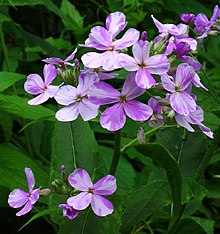Hesperis matronalis
| Hesperis matronalis | |
|---|---|
 |
|
| Scientific classification | |
| Kingdom: | Plantae |
| (unranked): | Angiosperms |
| (unranked): | Eudicots |
| (unranked): | Rosids |
| Order: | Brassicales |
| Family: | Brassicaceae |
| Genus: | Hesperis |
| Species: | H. matronalis |
| Binomial name | |
|
Hesperis matronalis L. |
|
Hesperis matronalis is a herbaceous plant species in the mustard family, Brassicaceae. It has numerous common names, including dame's rocket, damask violet, dame's-violet,dames-wort, dame's gilliflower, night-scented gilliflower, queen's gilliflower, rogue's gilliflower, summer lilac, sweet rocket, mother-of-the-evening and winter gilliflower. Plants are biennials or short-lived perennials, native to Eurasia and cultivated in many other areas of the world for their attractive, spring-blooming flowers. In some of those areas, it has escaped cultivation and become a weed species. The genus name Hesperis is Greek for evening, and the name was probably given because the scent of the flowers becomes more conspicuous towards evening.
Hesperis matronalis grows 100 cm or taller, with multiple upright, hairy stems. Typically, the first year of growth produces a mound of foliage, and flowering occurs the second year; the plants are normally biennials, but a number of races can be short-lived perennials. The plants have showy blooms in early to mid spring. The leaves are alternately arranged on upright stems and lanceolate-shaped; they typically have very short or lack petioles and have toothed margins, but sometimes are entire and are widest at the base. The foliage has short hairs on the top and bottom surfaces that give the leaves a somewhat rough feel. The larger leaves are around 12 cm long and over 4 cm wide. In early spring, a thick mound of low-growing foliage is produced; during flowering the lower parts of the stems are generally unbranched and denuded of foliage and the top of the blooming plant might have a few branches that end in inflorescences.
The plentiful, fragrant flowers are produced in large, showy, terminal racemes that can be 30+ cm tall and elongate as the flowers of the inflorescence bloom. When stems have both flowers and fruits, the weight sometimes causes the stems to bend. Each flower is large (2 cm across), with four petals. Flower coloration varies, with different shades of lavender and purple most common, but white, pink, and even some flowers with mixed colors exist in cultivated forms. A few different double-flowered varieties also exist. The four petals are clawed and hairless. The flowers have six stamens in two groups, the four closest to the ovary are longer than the two oppositely positioned. Stigmas are two-lobed. The four sepals are erect and form a mock tube around the claws of the petals and are also colored similarly to the petals.
...
Wikipedia
